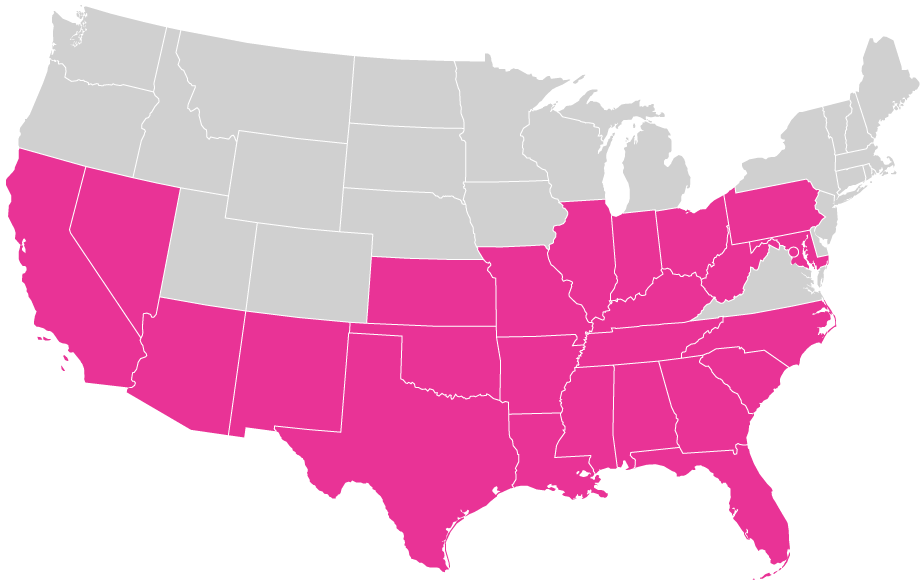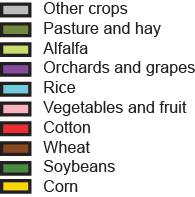Acephate
a-suh-fayt
High residues found on basil, cilantro, and other crops. Registered as a U.S. pesticide in 1955. Reregistered in 2006. Currently under registration review.
Overview
Acephate is used in 25 states.

Acephate is used in Alabama, Arizona, Arkansas, California, Florida, Georgia, Illinois, Indiana, Kansas, Kentucky, Louisiana, Maryland, Mississippi, Missouri, Nevada, New Mexico, North Carolina, Ohio, Oklahoma, Pennsylvania, South Carolina, Tennessee, Texas, Virginia, and West Virginia.
Data is not available for Alaska, D.C., Hawaiʻi, and U.S. Territories. Data represents the most recent year available from USGS. Details.
See detailed maps of acephate usage by state and county.
Human Health Effects
Even at low levels of exposure, acephate can lead to serious negative health effects.
Cancer
Neurodevelopmental Harm
High Risk Exposure Routes
People are exposed to acephate through food and drinking water, even if they don’t live near areas where pesticides are sprayed. Details.
Food and/or Drinking Water
FarmworkersPeople performing post-application activities in previously treated fields, but do not directly apply pesticides themselves. Details.
Pesticide HandlersPeople involved in pesticide application process. Details.
ResidentialExposure through post-application.
Residential BystanderPeople who live near areas where pesticides are applied. Details.
Spray Drift
High Residue Foods
Where residue levels of acephate exceeded allowable limits or were not legally allowed to have residues. Details.
Basil
Cilantro
Mangoes
Mustard Greens
Percentage of Crops
Acephate is applied on food widely grown and consumed in the United States.
Celery (70%)
Lettuce (70%)
Green Beans (60%)
Peppers (50%)
Cauliflower (30%)
Registered Uses
Where EPA allows acephate to be used.
Agricultural Crops: cotton, fruit and vegetables, orchards and grapes, soybeans, other crops
Christmas Tree Plantations
Cotton and Peanut Seed Treatment
Golf Courses
Indoor Use in Industrial/Commercial Buildings
Ornamental Lawns/Turf
Ornamental Plants
Outdoor Use on Building Foundations/Perimeters
Residential Lawns/Ornamentals
Sod Farms
Additional Information
Estimated Use of Acephate on Crops
Most recent agricultural crop usage data as provided by the U.S. Geographical Survey’s Pesticide National Synthesis Project. Does not reflect universal usage of acephate. (How do EPest-low and EPest-high differ?)
U.S. Tolerances Categories & Commodities for Acephate
The U.S. EPA sets maximum residue limits — known as “tolerances” — on the amount of acephate that may remain in and on foods. The tolerance is the residue level that triggers enforcement actions.
Tolerances have been set for acephate for: Agricultural Commodities and Milk Eggs Meat and/or Poultry. Maximum residue limits have been set for acephate by the U.S. EPA for the following commodities:
Brussel Sprouts
Cattle
Cauliflower
Cotton
Cranberry
Eggs
Hog
Horse
Lettuce
Peanut
Pepper
Peppermint
Sheep
Soybean
Spearmint
U.S. EPA Human Health Risk Assessments for Acephate
Human Health Risk Assessments are conducted by the U.S. EPA to estimate the nature and probability of harmful health effects in people who may be exposed to pesticide. They are used to make informed decisions about approving new pesticides and new uses of registered pesticides, and during our regular review of existing pesticides. Read the assessment for acephate.


